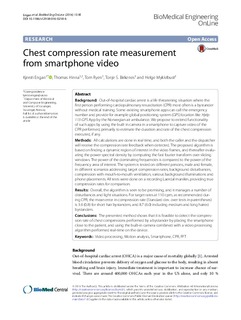| dc.contributor.author | Engan, Kjersti | |
| dc.contributor.author | Hinna, Thomas | |
| dc.contributor.author | Ryen, Tom | |
| dc.contributor.author | Birkenes, Tonje | |
| dc.contributor.author | Myklebust, Helge | |
| dc.date.accessioned | 2016-11-09T14:13:43Z | |
| dc.date.available | 2016-11-09T14:13:43Z | |
| dc.date.issued | 2016-08 | |
| dc.identifier.citation | Engan, K. et al. (2016) Chest compression rate measurement from smartphone video. BioMedical Engineering OnLine, 15(95), DOI 10.1186/s12938-016-0218-6 | nb_NO |
| dc.identifier.uri | http://hdl.handle.net/11250/2420348 | |
| dc.description | © 2016 The Author(s). This article is distributed under the terms of the Creative Commons Attribution 4.0 International License (http://creativecommons.org/licenses/by/4.0/), which permits unrestricted use, distribution, and reproduction in any medium, provided you give appropriate credit to the original author(s) and the source, provide a link to the Creative Commons license, and indicate if changes were made. | nb_NO |
| dc.description.abstract | Background: Out-of-hospital cardiac arrest is a life threatening situation where the
first person performing cardiopulmonary resuscitation (CPR) most often is a bystander
without medical training. Some existing smartphone apps can call the emergency
number and provide for example global positioning system (GPS) location like Hjelp
113-GPS App by the Norwegian air ambulance. We propose to extend functionality
of such apps by using the built in camera in a smartphone to capture video of the
CPR performed, primarily to estimate the duration and rate of the chest compression
executed, if any.
Methods: All calculations are done in real time, and both the caller and the dispatcher
will receive the compression rate feedback when detected. The proposed algorithm is
based on finding a dynamic region of interest in the video frames, and thereafter evaluating
the power spectral density by computing the fast fourier transform over sliding
windows. The power of the dominating frequencies is compared to the power of the
frequency area of interest. The system is tested on different persons, male and female,
in different scenarios addressing target compression rates, background disturbances,
compression with mouth-to-mouth ventilation, various background illuminations and
phone placements. All tests were done on a recording Laerdal manikin, providing true
compression rates for comparison.
Results: Overall, the algorithm is seen to be promising, and it manages a number of
disturbances and light situations. For target rates at 110 cpm, as recommended during
CPR, the mean error in compression rate (Standard dev. over tests in parentheses)
is 3.6 (0.8) for short hair bystanders, and 8.7 (6.0) including medium and long haired
bystanders.
Conclusions: The presented method shows that it is feasible to detect the compression
rate of chest compressions performed by a bystander by placing the smartphone
close to the patient, and using the built-in camera combined with a video processing
algorithm performed real-time on the device. | nb_NO |
| dc.language.iso | eng | nb_NO |
| dc.publisher | BioMed Central | nb_NO |
| dc.rights | Navngivelse 3.0 Norge | * |
| dc.rights.uri | http://creativecommons.org/licenses/by/3.0/no/ | * |
| dc.subject | chest compression | nb_NO |
| dc.subject | cardiac arrest | nb_NO |
| dc.subject | video processing | nb_NO |
| dc.subject | motion analysis | nb_NO |
| dc.subject | CPR | nb_NO |
| dc.subject | smart phone | nb_NO |
| dc.subject | smarttelefoner | nb_NO |
| dc.subject | hjerte-lunge-redning (HLR) | nb_NO |
| dc.subject | FFT | nb_NO |
| dc.subject | hjertestans | nb_NO |
| dc.subject | hjerte- og lungeredning | |
| dc.title | Chest compression rate measurement from smartphone video | nb_NO |
| dc.type | Journal article | nb_NO |
| dc.type | Peer reviewed | nb_NO |
| dc.subject.nsi | VDP::Medical disciplines: 700 | nb_NO |
| dc.subject.nsi | VDP::Technology: 500::Information and communication technology: 550 | nb_NO |
| dc.source.volume | 15 | nb_NO |
| dc.source.journal | BioMedical Engineering OnLine | nb_NO |
| dc.source.issue | 95 | nb_NO |
| dc.identifier.doi | 10.1186/s12938-016-0218-6 | |

